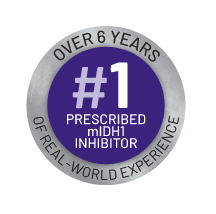TIBSOVO HAS STRONG EFFICACY DATA IN R/R MDS
aCR was defined as bone marrow ≤5% myeloblasts with normal maturation of all cell lines, hemoglobin ≥11 g/dL, platelets ≥100 x 109/L, neutrophils ≥1.0 x 109/L, and response lasting at least 4 weeks.2,3 43% of CR responders had baseline bone marrow blasts <5%.1
bDOCR was derived based on Kaplan-Meier method and is the date of the first documented CR (lasting ≥4 weeks) to the date of the first documented relapse or death, whichever was earlier.1 Plus sign (+) indicates a censored observation.
cSix out of 9 patients who were transfusion-dependent at baseline achieved transfusion independence.1 Postbaseline transfusion independence was defined as a period of ≥56 days with no red blood cell and/or platelet transfusions after the start of study treatment and on or before the end of study treatment.2,3
DOCR, duration of CR; mIDH1, mutated isocitrate dehydrogenase-1; NE, not estimable; R/R, relapsed or refractory.
IDH1 MUTATIONS ARE EARLY DRIVERS IN MDS PROGRESSION5,6
-
during the course of MDS
and can occur in up to 4% of patients
and the mutation rate may double in patients who progress to AML7,8
- Up to 40% of MDS patients progress to AML9
- Progression to AML occurs more frequently and rapidly in patients with high-risk MDS9
- at the first suspicion of clinical change8
- experiencing their first relapse1
aCategory 2A recommendation for lower-risk disease with symptomatic anemia, or with clinically relevant thrombocytopenia or neutropenia when used in the third line after immunosuppressive therapy (+/- eltrombopag), azacitidine, or decitabine, and for higher-risk disease in transplant patients when used as a single agent following no response to initial treatment, or in non-transplant patients when used following no response, intolerance, or relapse to initial treatment.10 Category 2B recommendation for lower-risk disease with clinically relevant thrombocytopenia and neutropenia when used in the second line following disease progression, no response, or relapse.
AML, acute myeloid leukemia; IDH1, isocitrate dehydrogenase-1; mIDH1, mutated IDH1; NCCN, National Comprehensive Cancer Network® (NCCN®).
CLASSIFICATION SYSTEMS ARE EVOLVING10
- Clinical classification systems continue to evolve to in distinguishing MDS from AML11
- Updated 2022 WHO and ICC guidelines focus heavily on 11
Consider how updated classifications may impact how your patients are diagnosed and managed.12,13
Learn moreAML, acute myeloid leukemia; ICC, International Consensus Classification; WHO, World Health Organization.

aClaims data as of 11/2024.2
